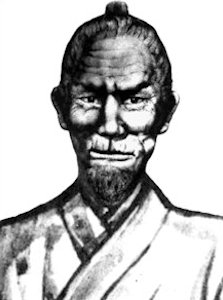Rainhill Kase Ha Shotokan Karate Academy

Master Sōkon "Bushi" Matsumura

Born in Yamakawa Village, Shuri, Okinawa, in 1796, Master Sōkon Matsumura was was one of the original karate masters of Okinawa. Master Matsumura was given the title "Bushi" meaning "warrior" by the Okinawan King in recognition of his abilities and accomplishments in the martial arts.
Described by Master Gichin Funakoshi as a sensei with a terrifying presence, Master Matsumura was never defeated in a duel, although he fought many. Master Matsumura was described by his student Master Ankō Itosu as blindingly fast and deceptively strong.
Master Matsumura's martial arts have been the progenitor of many contemporary karate styles including Shotokan and ultimately, all modern styles of karate can be traced back to the teachings of Master Matsumura.
Master Matsumura passed away in 1893, aged 97.
"Self-defence without common sense is like the earth without the sun".
Back to top
Matsumura's Makimono (scroll) or Precepts of Matsuura.
To: My Wise Young Brother Kuwae (Ryosei),
Through resolve and relentless training one will grasp the true essence of the fighting traditions. Hence, please consider my words deeply. No less interesting is the fundamental similarity between the fighting and literary traditions. By examining the literary phenomenon we discover three separate elements:
- the study of shisho,
- the study of kunko,
- the study of jukyo.
The study of shisho refers to commanding words and communicative skills.
The study of kunko refers to a comparative study in the philosophy of ancient documents and teaching a sense of duty through example. Yet, in spite of their uniqueness, they are incapable of finding the Way. Capturing only a shallow understanding of the literary phenomenon, shisho and kunko cannot, therefore, be considered complete studies.
It is in the study of jukyo, or Confucianism, that we can find the Way. In finding the Way we can:
- gain a deeper understanding of things,
- build strength from weakness,
- make our feelings more sincere,
- become virtuous,
- administer our own affairs more effectively or better control our emotions,
- in doing so make our home a more peaceful place - a precept which can also apply to our country or the entire world.
This then is a complete study and it is called jukyo.
Scrutinizing the fighting disciplines we also discover three divisions:
- gakushi no bugei:
a psychological game of strategy practiced by scholars and court officials,
- meimoku no bugei:
nominal styles of purely physical form, which aim only at winning (without virtue, participants are known to be argumentative, often harm others or even themselves, and occasionally bring shame to their parents, brothers, and family members),
- budo no bugei:
the genuine methods which are never practiced without conviction, and through which participants cultivate a serene wisdom which knows not contention or vice. With virtue, participants foster loyalty among family, friends, and country, and a natural decorum encourages a dauntless character.
With the fierceness of a tiger and the swiftness of a bird, an indomitable calmness makes subjugating any adversary effortless. Yet, 'budo no bugei':
- forbids wilful violence (it prohibits intentional violence),
- governs the warrior (it rules the actions of the warrior),
- fortifies people (it edifies),
- fosters virtue (it promotes virtue),
- appeases the community (it promotes peace among the people),
- and brings about a general sense of harmony and prosperity (it produces harmony in society & It brings about prosperity).
These are called the "Seven Virtues of Bu," and they have been venerated by the seijin (sagacious person or persons; most probably Chinese Confucians) in the document titled Godan-sho (an ancient journal describing the ways of China). Hence, the way of bun bu (study of philosophy and the fighting traditions, often described as "the pen [or brush] and the sword") have mutual features. A scholar needs not gakushi or meimoku no bugei, only budo no bugei. This is where you will find the Way. This indomitable fortitude will profoundly affect your judgment in recognizing opportunity and reacting accordingly, as the circumstances always dictate the means.
I may appear somewhat unsympathetic, but my conviction lies strongly in the principles of budo no bugei. If you embrace my words as I have divulged to you, leaving no secrets and nothing left hiding in my mind, you will find the Way.
Matsumura Bucho, May 13th (c.1882)
"We rise by lifting others".
Back to top
© Rainhill Kase Ha Shotokan Karate Academy. All Rights Reserved.